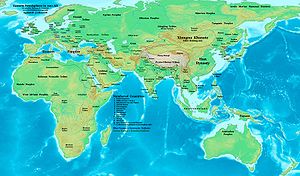AD 1
| Millennium: | 1st millennium |
|---|---|
| Centuries: | |
| Decades: | |
| Years: |
| AD 1 by topic |
|---|
| Leaders |
| Categories |
| Gregorian calendar | AD 1 I |
| Ab urbe condita | 754 |
| Assyrian calendar | 4751 |
| Balinese saka calendar | N/A |
| Bengali calendar | −592 |
| Berber calendar | 951 |
| Buddhist calendar | 545 |
| Burmese calendar | −637 |
| Byzantine calendar | 5509–5510 |
| Chinese calendar | 庚申年 (Metal Monkey) 2698 or 2491 — to — 辛酉年 (Metal Rooster) 2699 or 2492 |
| Coptic calendar | −283 – −282 |
| Discordian calendar | 1167 |
| Ethiopian calendar | −7 – −6 |
| Hebrew calendar | 3761–3762 |
| Hindu calendars | |
| - Vikram Samvat | 57–58 |
| - Shaka Samvat | N/A |
| - Kali Yuga | 3101–3102 |
| Holocene calendar | 10001 |
| Iranian calendar | 621 BP – 620 BP |
| Islamic calendar | 640 BH – 639 BH |
| Javanese calendar | N/A |
| Julian calendar | AD 1 I |
| Korean calendar | 2334 |
| Minguo calendar | 1911 before ROC 民前1911年 |
| Nanakshahi calendar | −1467 |
| Seleucid era | 312/313 AG |
| Thai solar calendar | 543–544 |
| Tibetan calendar | 阳金猴年 (male Iron-Monkey) 127 or −254 or −1026 — to — 阴金鸡年 (female Iron-Rooster) 128 or −253 or −1025 |
AD 1 (I) or 1 CE was a common year starting on Saturday or Sunday,[note 1] a common year starting on Saturday by the proleptic Julian calendar, and a common year starting on Monday by the proleptic Gregorian calendar. It is the epoch year for the Anno Domini (AD) Christian calendar era, and the 1st year of the 1st century and 1st millennium of the Christian or Common Era (CE).
In the Roman Empire, AD 1 was known as the "Year of the consulship of Gaius Caesar and Lucius Paullus",[1] and less frequently, as the year AUC 754 (see ab urbe condita). The denomination "AD 1" for this year has been in consistent use since the mid-medieval period when the Anno Domini (AD) calendar era became the prevalent method in Europe for naming years. It was the beginning of the Christian era/common era. The preceding year is 1 BC; there is no year 0 in this numbering scheme. The Anno Domini dating system was devised in AD 525 by Dionysius Exiguus.
The Julian calendar, a 45 BC reform of the Roman calendar, was the calendar used by Rome in AD 1.
Events
[edit]By place
[edit]Roman Empire
[edit]Asia
[edit]- Confucius is given his first royal title (posthumous name) of Baocheng Xuan Ni Gong.[3][4]
By topic
[edit]Religion
[edit]- Birth of Jesus, as assigned by Dionysius Exiguus in his anno Domini era according to at least one scholar.[5][6] However, most scholars think that Dionysius placed the birth of Jesus in the previous year, 1 BC.[5][6] Furthermore, most modern scholars do not consider Dionysius' calculations authoritative, placing the event several years earlier (see Chronology of Jesus).[7]
World population
[edit]Births
[edit]- Sextus Afranius Burrus, Roman praetorian prefect (d. AD 62)
- Izates II, King of Adiabene (d. AD 54)
- Seneca the Younger, Roman stoic philosopher was born in Cordoba (d. AD 65)[8]
Deaths
[edit]- Amanishakheto, queen of Kush (Nubia)
Gallery
[edit]References
[edit]- ^ "Fasti Capitolini (2) - translation". www.attalus.org. Retrieved September 7, 2024.
- ^ Velleius Paterculus, The Roman History, Book II. p 271.
- ^ Thomas A. Wilson (2003), in Xinzhong Yao (Ed.), RoutledgeCurzon Encyclopedia of Confucianism, "Baocheng Xuan Ni Gong", p. 26.
- ^ Book of Han, 12.351
- ^ a b Declercq 2000.
- ^ a b Declercq 2002.
- ^ Dunn 2003.
- ^ Vogt, Katja (February 13, 2024). "Seneca". Stanford Encyclopedia of Philosophy. Retrieved February 23, 2024.
Sources
[edit]- Declercq, Georges (2000). Anno Domini: The origins of the Christian Era. Turnhout, Belgium: Brepols. pp. 143–147. ISBN 978-2503510507.
- Declercq, Georges (2002). "Dionysius Exiguus and the introduction of the Christian Era". Sacris Erudiri. 41. Brussels: Brepols: 165–246. doi:10.1484/J.SE.2.300491. ISSN 0771-7776.
Annotated version of a portion of Anno Domini
- Dunn, James D. G. (2003). Jesus Remembered. Christianity in the Making. Vol. 1. Eerdmans Publishing. p. 324. ISBN 978-0802839312.
Footnotes
[edit]- ^ Sources disagree regarding the starting day of Julian year Anno Domini I (see leap year error for further information).



